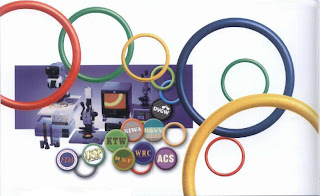Gaskets
Thursday, August 02, 2007
Yesterday, I attended a very interesting and informative training about gaskets. I never imagine that there are a lot to learn and explore about gaskets. After attending the training (delivered by Nipseal), my comprehension on gasket improved and I began appreciating it more. From the training, I know that there are various types and material of gaskets. Prices of gaskets vary a lot and some type of gasket is very tedious and difficult to manufactured/fabricated. Well, what is a gasket? According to Wikipedia, a gasket is a mechanical seal that fills the space between two objects, generally to prevent leakage between the two objects while under compression.
Other definitions/descriptions of gasket:
"A flexible material used to seal components together; either air-tight or water-tight" (PartSelect.com).
"Any of a wide variety of seals or packings used between matched machine parts or around pipe joints to prevent the escape of a gas or fluid" (Staffgasket.com).
Gaskets are commonly produced by cutting from sheet materials, such as gasket paper, rubber, silicone, metal, felt, fiberglass, or a plastic polymer.
Gaskets save money by allowing less precise mating surfaces on machine parts which can use a gasket to fill irregularities. Gaskets are commonly produced by cutting from sheet materials, such as gasket paper, rubber, silicone, metal, cork, felt, fiberglass, or a plastic polymer (such as polychlorotrifluoroethylene). Gaskets for specific applications may contain asbestos. It is usually desirable that the gasket be made from a material that is to some degree compressible such that it tightly fills the space it is designed for, including any slight irregularities.
gasket to fill irregularities. Gaskets are commonly produced by cutting from sheet materials, such as gasket paper, rubber, silicone, metal, cork, felt, fiberglass, or a plastic polymer (such as polychlorotrifluoroethylene). Gaskets for specific applications may contain asbestos. It is usually desirable that the gasket be made from a material that is to some degree compressible such that it tightly fills the space it is designed for, including any slight irregularities.
Gasket is very important in a process plant. It maintains the energy, temperature and pressure in a process system. Selecting a suitable gasket is a must because it does cost money. It is also directly related to the process temperature, pressure, type of medium (fluid or gas) and the chemical properties of the medium.
Another new knowledge that I learned is about spiral wound gasket that can withstand pressure up to 70-80 bar. It is a very interesting and carefully manufactured gasket made of stainless steel. However, I shall elaborate more about this in another post because it is deserve its own post!
OK, let me just explain about the simple/normal gasket. With reference to the left illustration, the gasket is sandwiched between flanges. The property of the gasket and correct compression/tightness allows the process system to maintains it pressure and would not allow oil or gas to leak.
 Another illustration shows how a gasket is positioned and locked between those 8 bolts.
Another illustration shows how a gasket is positioned and locked between those 8 bolts. We install/fix the correct type of gasket before connecting the pipeline with flanges.
We install/fix the correct type of gasket before connecting the pipeline with flanges. The above photo is a very interesting one. It shows the condition of gasket after being used for some time. It is difficult to remove the gasket by bare hands because the gasket sticks very well. We need to use suitable tools to peel and remove the gasket from the flanges. Usually, flanges like this is opened during shutdown to clean/clear pipelines or vessels. After inspection, a new fresh gasket will be used. Never use a gasket twice.
The above photo is a very interesting one. It shows the condition of gasket after being used for some time. It is difficult to remove the gasket by bare hands because the gasket sticks very well. We need to use suitable tools to peel and remove the gasket from the flanges. Usually, flanges like this is opened during shutdown to clean/clear pipelines or vessels. After inspection, a new fresh gasket will be used. Never use a gasket twice.
Gasket is not only used between flanges. It is widely used everywhere in a process plant and in our kitchen (the refrigerator). In a plant, gasket can be found in the heat exchanger, valves, vessel man holes etc. The gasket needs to be properly maintained to ensure no upsets in the plant.
Enjoyed this post? Subscribe to CHEMICAL ENGINEERING WORLD by email.
Or you can also Subscribe to CHEMICAL ENGINEERING WORLD by RSS.
Labels: Chemical Plant, Leak, Learning Curve, Plant Shutdown, Process Parameters
posted by Kipas Repair JB @ 10:22 PM,
![]()
0 Comments:
The Author
I’m Zaki. I used to be a project, process and chemical engineer. Few years ago I successfully became a Chartered Engineer (IChemE) and Professional Engineer (BEM). I'm now employed as a chemical engineering educator/researcher/consultant. Hope you like reading my blog. I welcome any feedback from you. My email: zaki.yz[alias]gmail.com. TQ!
